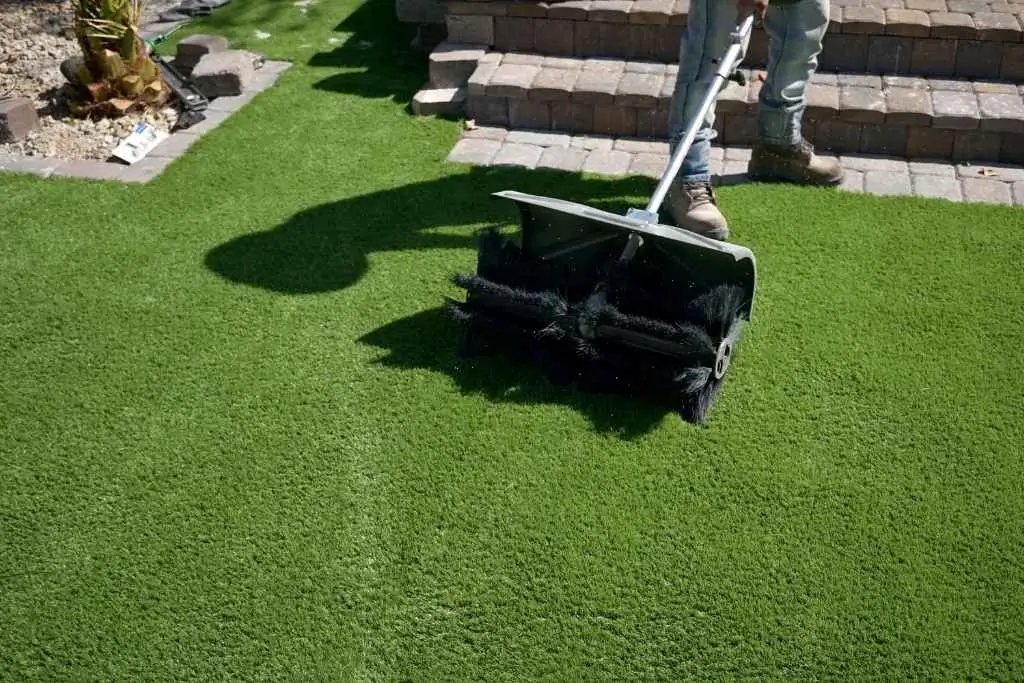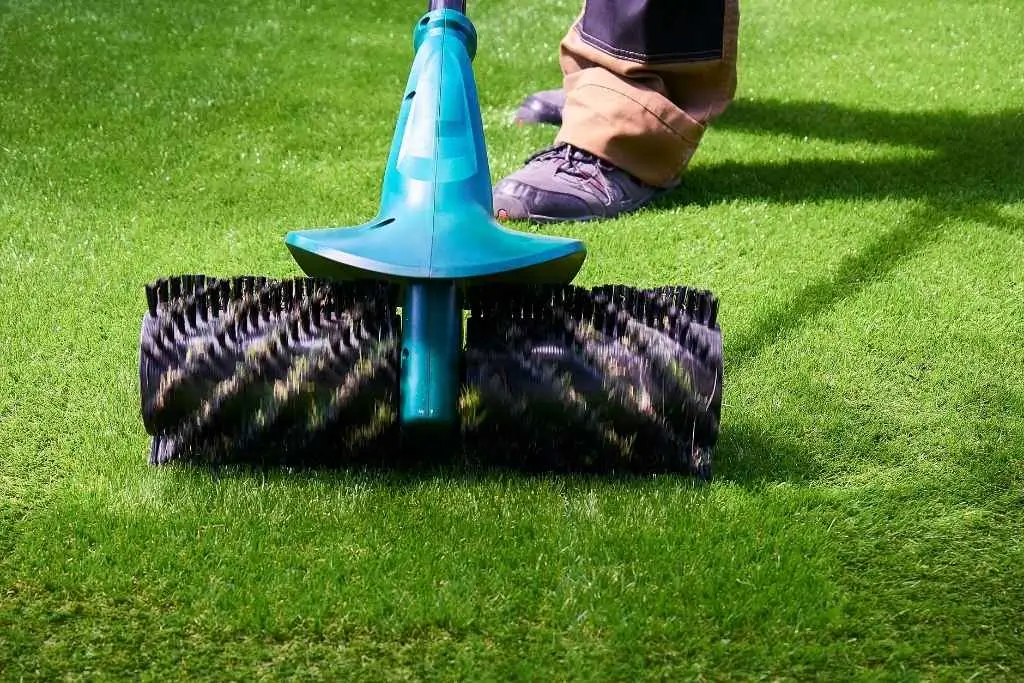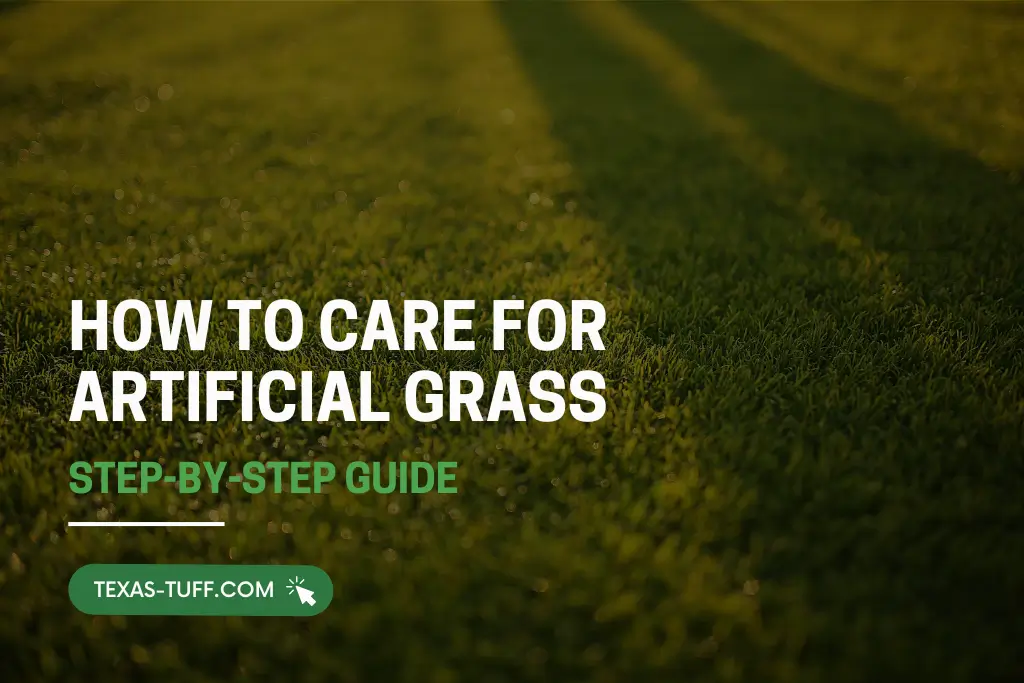Did you know that artificial grass can stay lush, green, and picture-perfect for up to 10-20 years with the right care?
Artificial lawns don’t require the usual chores that come with natural grass. That means no:
- Watering
- Mowing
- Fertilizing
Still, that doesn’t mean you can just install it and forget about it completely.
Artificial turf is low-maintenance, not no-maintenance. With a little routine care, you can keep it looking fresh while extending its lifespan. Simple tasks like:
- Brushing away debris
- Rinsing off dust
- Handling pet messes
…make all the difference in keeping your lawn soft, clean, and inviting.
So, what does artificial grass maintenance actually involve? And how can you make sure your lawn stays beautiful season after season?
This step-by-step guide breaks it all down for you.
Why Maintenance Matters for Artificial Grass
One of the main reasons homeowners switch to artificial grass is because it’s much lower-maintenance than a natural lawn. No more endless mowing, watering, fertilizing, or stressing over brown patches in the summer.
That said, synthetic turf is tough and durable, but it still benefits from a little TLC. Regular care helps it handle heavy foot traffic, pets, and all types of weather.
- Heavy foot traffic
- Pets
- All types of weather
And the payoff is worth it. Routine maintenance ensures:
- A longer lifespan – quality turf can last 15–20 years with proper care.
- A fresh, natural look – brushing and rinsing keeps blades upright and debris-free.
- Better hygiene – essential if kids or pets play on the lawn.
- Fewer repairs – prevents matting, odors, and buildup that can cause long-term damage.
With just a little attention, your artificial grass will stay green, clean, and welcoming for many years.
What Are the Essential Tools for Artificial Grass Care?
Caring for artificial grass doesn’t require a shed full of equipment. One of the best things about synthetic turf is how few tools you really need to keep it looking its best.
With just a handful of items, you’ll be ready to handle everyday maintenance. Here are the essentials every artificial grass owner should have:
- Soft-Bristle Brush or Broom: Keeps blades upright and prevents matting, especially in high-traffic areas like play zones or pet spots. Avoid metal rakes or stiff wire brushes, which can damage the turf fibers.
- Garden Hose with Spray Nozzle: A quick rinse removes dust, pollen, and minor spills. For larger lawns, consider a hose attachment that provides an even spray.
- Plastic Leaf Rake or Blower: Clears leaves, twigs, and other debris without tugging at the turf. A lightweight leaf blower works well for bigger yards.
- Mild Soap & Bucket: Diluted soap and water is perfect for spot-cleaning spills or pet accidents without harming the turf.
- Enzyme Cleaner (Optional): Especially helpful for pet owners, enzyme sprays break down odors and bacteria to keep your lawn fresh.
With these simple tools, you can keep your artificial grass clean, soft, and inviting, without the heavy lifting required by a traditional lawn.

How to Care for Your Artificial Grass
Keep your artificial lawn lush and inviting year-round with a few simple care steps. Regular brushing, rinsing, removing pet messes, controlling weeds, and protecting your turf from heat will keep it soft, clean, and looking its best for years to come.
Step 1: Regular Brushing to Keep Grass Upright
One of the simplest and most important tasks in artificial grass care is brushing. Over time, foot traffic, pets, and even the wind can cause the blades to flatten or lean in one direction. Regular brushing keeps your lawn looking natural and lush.
How to brush your artificial grass:
- Choose the right brush: Use a soft-bristle broom or a brush designed for synthetic turf. Avoid metal brushes as they can damage the fibers.
- Brush against the grain: Go against the direction the grass naturally lies to lift the blades and restore volume.
- Focus on high-traffic areas: Pay extra attention to pathways, play areas, and spots where pets spend the most time.
- Frequency: Most lawns do well with brushing once every 1–2 weeks. Heavily used areas may need more frequent attention.
Regular brushing not only keeps your lawn looking fresh but also:
- Prevents matting
- Extends the life of the turf
- Helps water and cleaning solutions reach the roots more effectively
Pro Tip: If your lawn has infill (sand or rubber granules), brushing also redistributes the infill evenly, keeping the turf stable and soft underfoot.
Step 2: Removing Leaves, Dust, and Debris
Even though artificial grass doesn’t grow dirt or weeds like a natural lawn, debris such as leaves, twigs, pollen, and dust can still accumulate on the surface. Regular removal keeps your lawn looking clean and prevents buildup that could affect drainage or flatten the blades.
How to clear debris effectively:
- Use a leaf blower or plastic rake: Gently remove leaves and twigs without pulling on the turf fibers. Avoid metal rakes as they can damage the grass.
- Sweep smaller particles: Dust, pollen, and light debris can be brushed away with a soft-bristle broom.
- Check corners and edges: Debris often collects along fences, walls, and garden beds, so give these areas special attention.
- Frequency: For most lawns, a quick debris removal once a week is enough. In the fall, you may need to do this more often as leaves drop.
Keeping your artificial grass free from debris not only preserves its appearance but also:
- Ensures rainwater drains properly
- Prevents unwanted smells
- Reduces the risk of mold growth
Pro Tip: For large lawns, a lightweight leaf blower can save time and energy, making debris removal quick and effortless.
Step 3: Rinsing Your Lawn to Stay Fresh
Even though artificial grass doesn’t need watering like natural lawns, giving it a regular rinse helps keep it:
- Clean
- Cool
- Free from dust, pollen, or light dirt
Rinsing is especially important for homes with pets, as it prevents lingering odors and keeps the turf hygienic.
How to rinse your artificial grass:
- Use a garden hose: A simple spray nozzle is usually enough to remove dust and light debris. For larger areas, consider a hose with an adjustable spray pattern for even coverage.
- Focus on problem areas: Pay extra attention to high-traffic spots, shady areas where debris collects, and pet zones.
- Frequency: For most yards, rinsing once every 1–2 weeks is sufficient. In hot, dusty climates, you may want to rinse more often to keep the grass looking vibrant.
- Optional soap solution: For tougher stains, mix a mild soap with water and lightly rinse the area. Avoid harsh chemicals as they can damage the turf fibers.
Rinsing your artificial grass not only refreshes its appearance but also:
- Helps maintain hygiene
- Reduces dust accumulation
- Keeps your lawn cool
Pro Tip: In regions with hard water, a quick rinse with plain water after using soap can prevent residue buildup and keep the grass looking natural.
Step 4: Cleaning Up Pet Waste Properly
Artificial grass is a game-changer for pet owners, staying green and odor-free with the right care. However, pet waste still needs attention to keep your lawn hygienic and smelling fresh.
How to handle pet waste on artificial grass:
- Solid waste: Pick up solid waste daily using a pooper-scooper or a bag. This prevents staining and keeps the lawn sanitary.
- Urine spots: Rinse areas where pets frequently urinate with water to prevent odor buildup. For extra freshness, use a pet-friendly enzyme cleaner to break down bacteria and eliminate smells.
- Deep cleaning: For heavily used areas, occasionally hose down the turf more thoroughly to flush away any trapped waste and debris.
- Frequency: Daily cleanup for solid waste and weekly rinsing for urine spots is ideal for maintaining a clean, odor-free lawn.
Proper pet maintenance ensures your synthetic grass stays:
- Green
- Soft
- Enjoyable for the whole family, human and furry alike
Pro Tip: Avoid harsh chemicals when cleaning pet areas, as these can damage the grass fibers or leave a residue that is harmful to pets.
Step 5: Preventing Weeds and Moss Growth
Even though artificial grass greatly reduces weed problems compared to natural lawns, weeds and moss can still appear along edges, seams, or in areas with poor drainage. Staying on top of this helps your lawn look neat and well-kept.
How to prevent weeds and moss:
- Use a weed barrier: Most quality turf installations include a weed membrane underneath. Check that it is intact and replace or repair any damaged sections.
- Manual removal: Pull any weeds that do appear promptly to prevent them from spreading.
- Treat with pet-friendly weed killer: For stubborn weeds or moss, use a safe, non-toxic solution that will not harm pets or damage the grass fibers.
- Ensure proper drainage: Standing water encourages moss growth. Make sure water flows freely and infill is properly distributed to avoid damp patches.
Regular inspections and quick action keep your synthetic lawn looking clean and uniform all year.
Pro Tip: Pay special attention to edges, joints, and shaded areas where moss and weeds are more likely to take hold.
Step 6: Protecting Grass from Heat & Heavy Use
Artificial grass is designed to handle sun, heat, and foot traffic, but a few precautions can prevent premature wear and keep it looking natural.
How to protect your turf:
- Avoid direct heat sources: Don’t place fire pits, grills, or hot equipment directly on the turf. Extreme heat can melt or discolor fibers.
- Use outdoor furniture pads: Heavy furniture can flatten blades. Placing pads under legs helps maintain the turf’s texture.
- Rotate high-traffic areas: Occasionally shift play equipment, furniture, or pet areas to prevent certain spots from matting.
- Keep it cool: In very hot climates, a quick water spray can help cool the grass and make it comfortable for pets or kids.
Taking these precautions helps your artificial grass stay:
- Soft
- Green
- Durable
Even under intense sun or heavy everyday use.

Seasonal Care Tips for Artificial Grass
Artificial grass is low-maintenance year-round, but giving it a little seasonal attention can keep it looking its best. Each season brings unique challenges, from pollen in the spring to leaf buildup in the fall.
Spring:
- Rinse the lawn to remove winter dust, debris, and any accumulated dirt.
- Check for moss or weeds starting to grow along edges and seams.
- Refresh infill if necessary, especially in high-traffic areas.
Summer:
- Brush the turf regularly to prevent matting from heavy foot traffic or furniture.
- Hose down the grass occasionally to remove dust and cool the surface during hot days.
- Inspect for any signs of sun or heat stress, especially on darker turf fibers.
Fall:
- Remove fallen leaves and debris weekly to prevent staining or mold growth.
- Check drainage systems to ensure rainwater flows freely.
- Brush areas where leaves may have flattened the blades.
Winter:
- Clear frost or snow gently using a plastic shovel or brush. Avoid metal tools that can damage fibers.
- Inspect seams and edges for any lifting caused by freeze-thaw cycles.
- Rinse the lawn occasionally if needed, especially in areas where salt or ice melt is applied.
Following these seasonal care tips helps your artificial grass remain:
- Lush
- Vibrant
- Ready for year-round use
No matter the weather conditions.
What Common Mistakes Can Shorten the Life of Your Artificial Grass?
Even though artificial grass is low-maintenance, a few missteps can shorten its lifespan or make it look less natural. Watch out for these:
- Using harsh chemicals: Strong cleaners, bleach, or ammonia can damage fibers and affect color. Stick to mild soaps or pet-friendly enzyme cleaners.
- Ignoring debris: Leaves, twigs, or dirt left on the lawn for long periods can cause matting, odor, or mold growth.
- Brushing incorrectly: Avoid metal or stiff brushes, they can flatten or damage blades. Always brush against the grain with a soft-bristle broom.
- Overwatering or heavy rinsing: Artificial grass doesn’t need watering. Too much water can wash away infill or create pooling.
- Neglecting high-traffic areas: Spots with pets, furniture, or frequent foot traffic may need extra attention. Failing to rotate or brush these areas can lead to uneven wear.
- Ignoring drainage issues: Poor drainage can cause water pooling, moss growth, or unpleasant odors.
Avoiding these common mistakes helps keep your artificial grass green, soft, and beautiful for years, without unnecessary repairs or replacements.
Keep Your Artificial Grass Looking Perfect Year-Round
Artificial grass is a fantastic way to enjoy a green, low-maintenance lawn without the hassle of:
- Watering
- Mowing
- Fertilizing
With just a little regular care, your turf can stay lush, soft, and vibrant for years.
Simple maintenance tasks make a big difference, such as:
- Brushing to lift the blades
- Rinsing to remove dust and pet debris
- Promptly clearing leaves, twigs, or spills
Paying attention to high-traffic areas also helps the lawn stay even and look natural.
Seasonal maintenance and occasional spot cleaning will:
- Extend the life of your grass
- Protect your investment
Whether you have pets, kids, or a busy backyard, following a consistent care routine keeps your synthetic lawn clean, safe, and beautiful.
With the right approach, artificial grass lets you enjoy a pristine, hassle-free yard year-round, without compromising on appearance or durability.
FAQs About Artificial Grass Maintenance
Brushing once every one to two weeks is usually enough for most lawns. High-traffic areas or pet zones may need more frequent brushing to keep the blades upright and looking natural.
Watering isn’t required for growth, but occasional rinsing helps remove dust, pollen, and pet urine. Rinsing can also cool the surface on hot days, making it more comfortable for pets and kids.
Avoid harsh chemicals like bleach or ammonia, as they can damage the fibers and affect the turf’s appearance. Stick to mild soaps or pet-safe enzyme cleaners to keep your lawn clean without compromising its integrity.
Pick up solid waste daily and rinse urine spots with water. For stubborn odors, a pet-safe enzyme cleaner works well by breaking down bacteria naturally and keeping the turf fresh.
High-quality synthetic turf is built to withstand both heat and cold. Avoid placing direct heat sources on the lawn, and gently clear frost or snow in winter to protect the fibers.
Most routine upkeep can be done by homeowners using basic tools. Professionals can help with deep cleaning, infill replacement, or repairing worn areas if needed.
Yes, synthetic turf is highly durable. Rotating furniture or play equipment and brushing regularly will help maintain an even, lush appearance over time.







